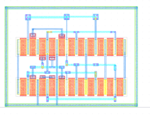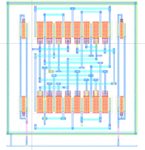deveshkm
Member level 4
This is the schematic. i am doing the layout for this
Each transistor has 4 fingers each
The three transistors on the right are for dummy
pp pn np nn are gate inputs
A: pp B: pn
C: np D: nn

I am using the following scheme
ABBA (DUMMY) CDDC
DCCD (DUMMY) BAAB
The routing is quite complex.
The layout is not complete , yet

Please suggest better scheme or tips on layout for this.
Each transistor has 4 fingers each
The three transistors on the right are for dummy
pp pn np nn are gate inputs
A: pp B: pn
C: np D: nn

I am using the following scheme
ABBA (DUMMY) CDDC
DCCD (DUMMY) BAAB
The routing is quite complex.
The layout is not complete , yet

Please suggest better scheme or tips on layout for this.
